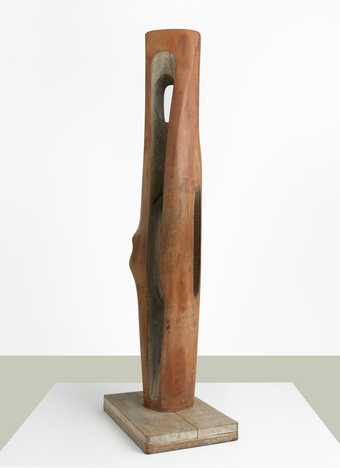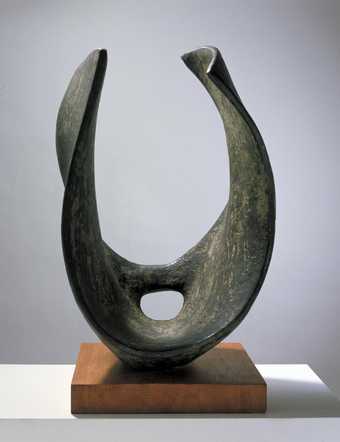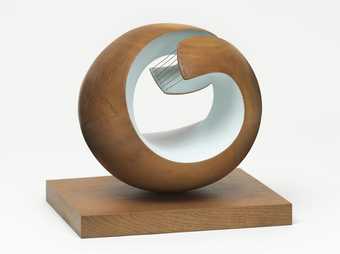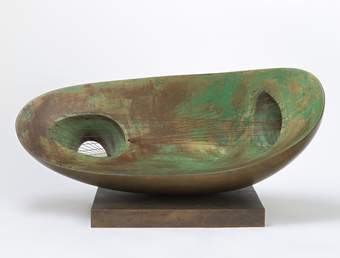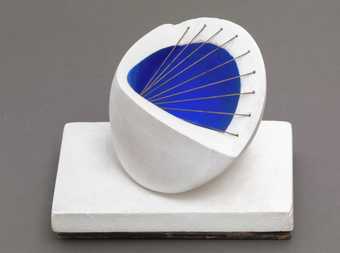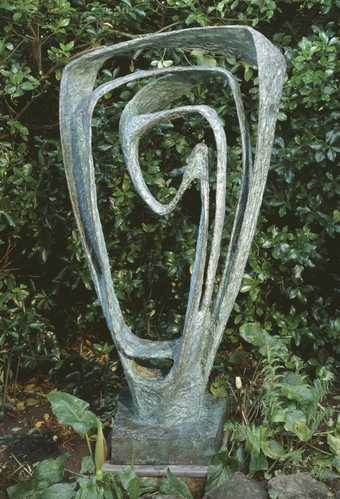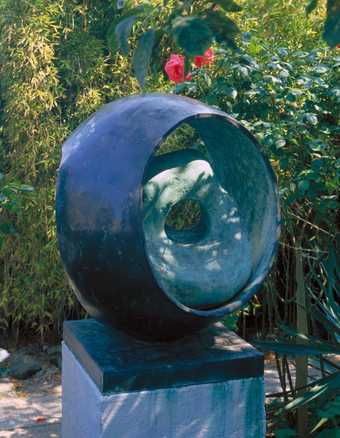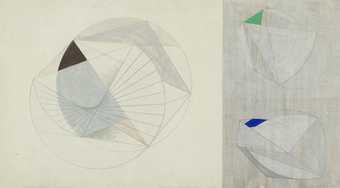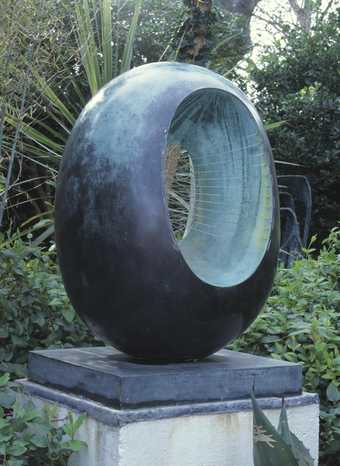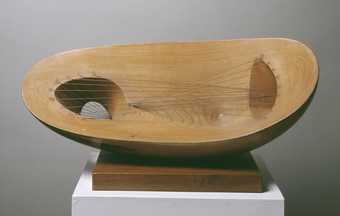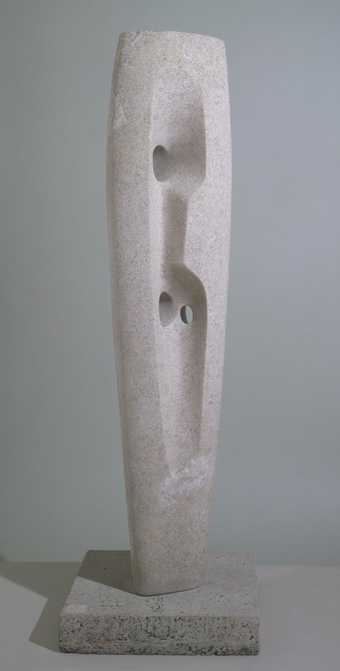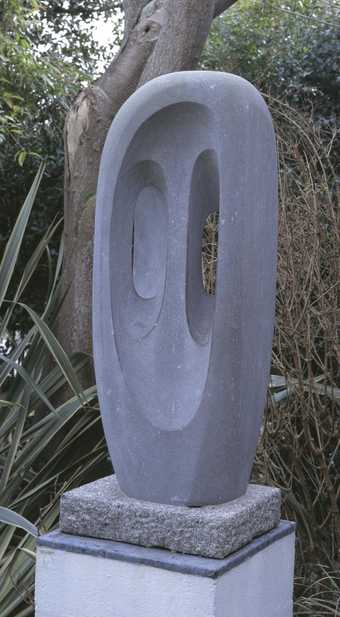
Not on display
- Artist
- Dame Barbara Hepworth 1903–1975
- Medium
- Plaster on wooden base
- Dimensions
- Object: 293 × 400 × 255 mm
- Collection
- Tate
- Acquisition
- Presented by the artist 1967
- Reference
- T00953
Display caption
In the 1930s Barbara Hepworth and her husband Ben Nicholson were members of the London-based avant-garde. Shortly before the outbreak of war they moved to Cornwall with their children. Hepworth’s abstract forms, which seem akin to caves and shells, were affected by the Cornish landscape. Her response to nature was not romantic or mystical but more firmly based on actual observation. Circles and spheres had dominated her work. These were replaced by ovals which gave her sculptures two centres rather than one, complicating their interior form.
Gallery label, November 2015
Does this text contain inaccurate information or language that you feel we should improve or change? We would like to hear from you.
Catalogue entry
Dame Barbara Hepworth
1903-1975
T00953 Oval Sculpture (No.2) 1943, cast 1958
BH 121.2
Plaster 293 x 400 x 255 (11 1/2 x 15 3/4 x 10 1/16) on a veneered wooden base 35 x 327 x 300 (1 3/8 x 11 3/4 x 11 7/8)
Weight: 14.4 kg
Presented by the artist 1967
Exhibited:
Barbara Hepworth: A Retrospective, Tate Gallery Liverpool, Sept.-Dec. 1994, Yale Center for British Art, New Haven, Feb.-April 1995, Art Gallery of Ontario, Toronto, May-Aug. (32, repr. in col. p.72)
Literature:
Barbara Hepworth, 'Approach to Sculpture', Studio, vol.132, no.643, Oct. 1946, p.98
Patrick Heron, Barbara Hepworth: Sculpture and Drawings, exh. cat., Wakefield City Art Gallery 1951, pp.4-5
E.H. Ramsden, Sculpture: Theme and Variation, London 1953, p.42
J.P. Hodin, Barbara Hepworth, Neuchâtel and London 1961, p.165 no.121
Tate Gallery Report 1967-8, London 1968, p.62
David Fraser Jenkins, Barbara Hepworth: A Guide to the Tate Gallery Collection at London and St Ives, Cornwall, London 1982, p.10, repr. p.26
Alan G. Wilkinson, 'Cornwall and the Sculpture of Landscape: 1939-1975' in Penelope Curtis and Alan G. Wilkinson, Barbara Hepworth: A Retrospective, exh. cat., Tate Gallery Liverpool 1994, pp.81-2
Following her first original bronzes two years previously, in 1958 Hepworth elected to make casts of selected earlier carvings as a means of increasing her output and, presumably, of further disseminating her work. She also chose the first work to be cast - her 1943 Oval Sculpture
in planewood with painted interior, which belonged to her friend Margaret Gardiner - because it had begun to split and she was anxious to preserve it. Brian Wall, an assistant of Hepworth's at that time, has recalled her borrowing the sculpture from Gardiner and bringing the renowned plaster caster 'Mac' Mancini from the Mancini-Tozer foundry in Wimbledon to St Ives for the purpose. Mancini, according to Wall, was horrified when he saw the complexity of the piece to be cast and insisted it would be too difficult. Nevertheless, he made a cast of it - along with a number of other carvings - in Hepworth's Trewyn Studio using a forty-piece mould (Brian Wall, interviewed by the author, 3 May 1996). Two plaster casts were made: the first belongs to the artist's estate and is on display in the Barbara Hepworth Museum, St Ives and the Tate Gallery's version is the second. An edition of four polished bronzes was cast in the following year at the Susse Fréres foundry in Paris (BH 121.3, artist's estate, repr. Barbara Hepworth, exh. cat., Tate Gallery 1968, p.16).
The Tate's plaster is in sound condition, though there is considerable evidence of its vulnerability to dirt and mechanical damage. Areas of the surface have been painted with an off-white, semi-glossy paint and there are numerous abrasions and chips, particularly along the edges of the holes. Two chips near the smallest opening have been repaired with a grey filler. Tool marks - specifically of file and riffler - are visible on the inner surfaces. Lines marking the divisions of the sections of mould are visible at various places on the sculpture. Testing with a magnet suggests that there is no armature and it is likely that the plaster is solid (Tate Gallery Conservation Files). The version of this plaster in the Barbara Hepworth Museum is marked with small rust spots; these are most likely to be flecks of iron in the plaster oxidising in the sea air rather than evidence of an armature. In both cases, the plaster is highly polished giving it a bone-like sheen.
Apparently 'evolved' from three abstract drawings of 1942 (Gibson 1946, p.8), the wooden original of Oval Sculpture
was among the first works carved by Hepworth after her move to Chy-an-Kerris, a large house overlooking the sea at Carbis Bay, in July 1942. There she and Nicholson had enough space for them both to have studios, though she continued to be restricted by domestic chores and a lack of materials. In September 1943 she asked Nicholson, then in London, to call a London timber merchant as she had 'a permit for English hardwood', but soon afterwards lamented: 'the outlook for my wood looks bad. I can get the wood but seasoned wood is extinct. Newly felled timber will split like hell' (letters to Nicholson, TGA 8717.1.1.277 & 278). Despite these hindrances, 1943 was important for her as she was invited at the beginning of the year to show with Paul Nash in an exhibition at Temple Newsam, Leeds from April to June. However, the only wartime sculpture she showed was the wooden version of Sculpture with Colour (Deep Blue and Red)
(Tate Gallery T03133), which suggests that no other carvings were ready for exhibition.
Oval Sculpture
is, essentially, an ovoid, the outer surface of which is pierced in four places to open up the curving space of its interior. It demonstrates the increasing complexity of Hepworth's piercing of the block during the 1940s. The sculpture epitomises a number of works of the mid 1940s by artists associated with St Ives which are ovoid in form. Naum Gabo, Peter Lanyon and John Wells all employed such forms and Sven Berlin has described how they were a cause of the considerable anxiety over mutual influence which culminated in a rift between Hepworth and Gabo (Sven Berlin, A Coat of Many Colours: An Autosvenography, 1994, pp.107-8). In 1946 Hepworth told E.H. Ramsden that the row with Gabo had 'started 3 yrs ago when he accused me of stealing the OVAL! and since that time I havn't [sic] seen any
of his work' (letter to E.H. Ramsden, nd [1946] TGA 9310). The 'open curvilinear rhythms of Hepworth's Oval Sculpture' have been specifically related to Gabo's paintings of the 1940s (Martin Hammer & Christina Lodder, 'Hepworth and Gabo: A Constructive Dialogue' in David Thistlewood (ed.), Barbara Hepworth Reconsidered, 1996, p.128), though it might be argued that her interest in light and interior space had developed from her first piercing of the block in the early 1930s. Similarly, one might see a precedent for her use of the oval in the pre-war carving Conicoid, 1939 (BH 112, Leeds City Art Gallery, repr. Herbert Read, Barbara Hepworth: Carvings and Drawings, 1952, pl.57a), which was exhibited the year before Oval Sculpture
was made (New Movements in Art, London Museum, March-May 1942). Subsequently, Hepworth produced a number of ovoid pieces, many of which were shown with Oval Sculpture
in her exhibition at the Lefevre Gallery in October 1946. At that time she discussed her interest in such shapes: 'The carving and piercing of such a form', she wrote, 'seems to open up an infinite variety of continuous curves in the third dimension, changing in accordance with the contours of the original ovoid and with the degree of penetration of the material' ('Approach to Sculpture', Studio, vol.132, no.643, Oct. 1946, p.98). Around the same time, in a letter repudiating her association with Constructivism and, speculatively, the term 'constructive', she told Ramsden, 'I could, for the rest of my life, take an egg form and in different
materials carve an infinite number of sculptures all giving [a] different sort of "life"' (letter to E.H. Ramsden nd [1946] TGA 9310).
Hepworth identified the ovoid in earlier works also: 'The first carvings were simple realistic oval forms of the human head or of a bird', she wrote ('Approach to Sculpture', p.97). Her insistence on the relationship between figurative motifs and abstract shapes echoes Brancusi's use of the ovoid as an archetypal form derived, in part, from the human head. Hepworth had visited the Romanian sculptor's Paris studio in 1933 and it seems inconceivable that her use of the oval was not informed by his work. Specifically, The Beginning of the World, c.1920, an egg-like carving in marble, had been in the collection of H.P. Roché, who had bought paintings by Ben Nicholson in 1930. In a 1944 discussion of the work of Henry Moore, Herbert Read cited the egg - juxtaposed with the Brancusi - as an exemplar of the organic form. He contrasted the organic approach and constructivism as two opposing forms of sculpture. Quoting D'Arcy Thompson's theory of the determination of form by natural processes, Read wrote: 'The egg is not an arbitrary shape; it is determined, as we say, by physical laws' ('Introduction', Henry Moore, London, 1944, p.xxiii).
While Alan Wilkinson's description of Oval Sculpture
as one of Hepworth's first 'direct references to the landscape and seascape of Cornwall' (Wilkinson 1994, p.82) may seem unlikely, the sculpture does signal the resurgence of a more generalised organicism as the central theme of her work. In December 1946 Hepworth wrote to Ramsden that she was 'deeply impressed by your article on "Oval Sculpture"' (letter to E.H. Ramsden, nd [Dec. 1946] TGA 9310); it is not clear to which article she referred, but Ramsden had published a piece on Hepworth in the September/October issue of Polemic. While not dealing with specific works, this short essay's proposition, pertinent to Oval Sculpture, is that a vital work of art is grounded in Nature and is, 'evolved in accordance with laws analogous to those of Nature and owe their being to a like necessity'. 'Is it not', Ramsden wrote, 'by the interpenetrations of the material, the convergence and recession of the planes, the dissolving curves of the interior and exterior surfaces, the stringing and the inner tensions of the configured whole that a sense of the cosmic rhythm of life ... is evoked' ('The Sculpture of Barbara Hepworth', Polemic
5, Sept./Oct. 1946, p.34).
That the oval might have had more specific, sub-conscious significance for the artist is suggested by a scheme of her iconography which she drew for Read in 1947 (repr. Thistlewood 1996, p.11). The drawing demonstrates the translation, through the medium of emotion and feeling, of what she describes as 'known symbols' to 'unknown symbols' and vice versa. On the left hand side she lists 'figures hands eyes trees etc' as examples of known symbols, and on the other: 'curves, spirals ovoids - foetus errotic [sic], prenatal dream, childhood - primitive etc?' (letter to Herbert Read, 6 March [1947], Herbert Read Archive, University of Victoria, B.C.). The conjunction of the ovoid form with themes relating to the foetus and childbirth indicates Hepworth's knowledge of psychoanalytic theory to which she was exposed through Read, whose Education Through Art
(1944) drew heavily on Jung's writings, and Adrian Stokes - a leading exponent of Melanie Klein. In Klein's development of Freud's Oedipus Complex, the infant attacks in fantasy the mother's womb and its contents; later in life it seeks to make reparation for this attack on the mother. Klein proposed that the making of a work of art might be seen as one manifestation of the reparative urge ('Infantile Anxiety Situations Reflected in a Work of Art and the Creative Impulse', International Journal of Psycho-Analysis, vol.10, 1929; reprinted in Juliet Mitchell, ed., The Selected Melanie Klein, 1986, pp.84-94). A work in the shape of an egg - the form and contents of the womb - may be seen to embody that desire for renewal in its organic completeness and its allusion to mechanisms of regeneration.
While such two part sculptures as Large and Small Form, 1945 (BH 128, Barbara Hepworth estate, repr. Read 1952, pls.79a-b) may appear to address the theme of generation, Oval Sculpture's concern with it appears to be confirmed by Hepworth's deliberations over the titling of this and similar works. Before her 1946 exhibition, she wrote to Ramsden, who provided her with Greek titles for some works. Of one piece, possibly the ovoid Sculpture with Colour (Eos), 1946 (BH141, Private Collection, repr. Hodin 1961), she wrote that it had the 'feeling of Genesis ... "the beginning" would be the right idea ... "Origin" ... "source" ... "Eiréne"'. The subsequent discussion is accompanied by a sketch of Oval Sculpture: 'Is there a word for 'evolution', she asked, 'I could cut out the spirit and call it "penetration" but that implies a physical act in some way & I don't like it. The form is evolving & the idea' (letter to E.H. Ramsden, nd [1946] TGA 9310). None of these options were eventually used, the use of a more generalised title stressing the formal aspect of the sculpture. In its use of an archetypal organic form to express a natural, passive process of growth, Oval Sculpture
may be seen to establish the tenor of Hepworth's work for the subsequent few years.
Chris Stephens
March 1998
Explore
- abstraction(8,615)
-
- from recognisable sources(3,634)
- non-representational(6,161)
-
- geometric(3,072)
- emotions and human qualities(5,345)
-
- creativity(1,349)
- environment / nature(315)
- body(4,878)
-
- head / face(2,497)
- womb(31)
- UK counties(19,585)
-
- Cornwall(1,034)
- England(19,202)
- England, South West(3,507)
- England, Southern(8,982)
You might like
-
Dame Barbara Hepworth Figure (Nanjizal)
1958 -
Dame Barbara Hepworth Curved Form (Trevalgan)
1956 -
Dame Barbara Hepworth Pelagos
1946 -
Dame Barbara Hepworth Landscape Sculpture
1944, cast 1961 -
Dame Barbara Hepworth Sculpture with Colour (Deep Blue and Red)
1940 -
Dame Barbara Hepworth Garden Sculpture (Model for Meridian)
1958 -
Dame Barbara Hepworth Sphere with Inner Form
1963 -
Dame Barbara Hepworth Drawing for ‘Sculpture with Colour’ (Forms with Colour)
1941 -
Dame Barbara Hepworth Spring
1966 -
Dame Barbara Hepworth Landscape Sculpture
1944 -
Dame Barbara Hepworth Image
1951–2 -
Dame Barbara Hepworth Stone Sculpture (Fugue II)
1956

